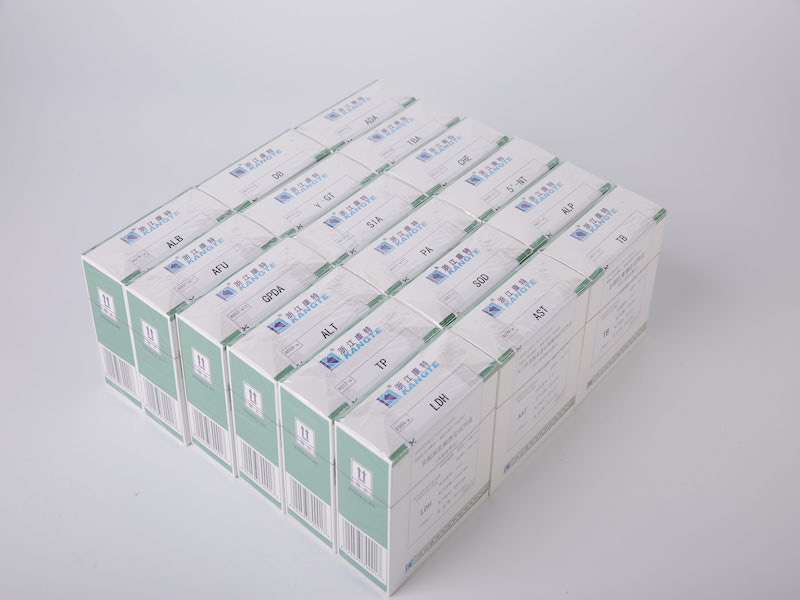Let us create a wonderful future together!
-L-Fucosidase Assay Kit offers an easy, sensitive and reliable method to identify physiological levels of the glycoside in a wide range of biological samples from several species. In this simple assay, -L-Fucosidase utilizes a beta-hydroxy acid (BA) derivative as a substrate and yields a highly sensitive and selective polar soluble compound that can be detected via mass spectra with sensitive detectors. It is a versatile tool for the detection and measurement of serum glycoside levels in human plasma and whole blood. Its unique sensitivity and speed make it an ideal laboratory compound for multiple clinical applications. This kit is ideal for use in clinical settings for measuring glucose and lipid levels in patients with diabetes, cardiac diseases, liver diseases, and other metabolic disorders.

Tips: these L-Fucosidase Assay Kit from zjkangte is usually used for the dynamic monitoring of hepatic cancer patients to assist in the diagnosis of disease progression or treatment effect.
The beta-hydroxy acid (BA) complex of -L-Fucosidase is capable of dissolving sugars, fats, and carbohydrates. In the clinical setting, this multi-reacting agent is often applied in combination with a protein digestion system such as Serrapeptase or N-acetyl-d Glucose Acetate (NAG), which is typically used in conjunction with a competitive binding assay (which requires microplates to contain specific substrates that have been coated with various chemicals, which in turn may be utilized in the binding reaction). Additional methods of binding may be used when available. For example, using sodium iodide can replace the need for microplates in the binding process.
The Beta-hydroxy acid-based kit is available in two variants. The suite includes four containers with glass vials with 405nm of Fluorite, one microcap, and one pellet. One of the vials contains a solution for providing electrolytes to the samples. All four packages of the Beta-hydroxy acid-based kit contain different concentrations of the acid. Depending on the clinical needs of the clinical trial, the appropriate balance of the alpha-l-fucosidase activity may be the one most suitable.
Samples of biological materials can be drawn at the Biorepository Procurement Laboratory of the Bioanalytical Integrative Facility (EAFL). The EAFL creates high quality, archival ink pads for analysis of biological samples. The kit consists of a reusable microcapillary bottle, microtialysis mix, and bead-dispersing microbeads. The bottles are closed with snap-on caps and contain one glass vial containing the experimental material sample. The microtialysis mix contains a fluorescent marker for colorimposition.
For experiments using live cells or tissues, the Biological Equipment Laboratory of the Molecular Resources Institute (MRI) has an afu assay. The afu assay contains seven wells and requires only one glass vial containing one hundred nucleotides. A sample plate of one hundred blank biological materials, diluted four times with phosphate-diluted buffer and six replicate wells on a glass plate is used for each replicate.
-L-fucose can be used for many biological applications in various biology laboratory investigations. One of these applications is to determine the levels of -L-fucose in aqueous media. In this application, a sample of one hundred micrograms of -L-fucose is added to six hundred ml of tap water. Three days later, a qualitative analysis can be done by adding two micrograms of -L-fucose to one hundred ml of reagent in a Petri dish. This sample is then incubated at 37 degrees C under aerobic and anaerobic conditions for one week.
The results show that -glucose 3-glutamic acid is abundantly produced in cells. Accordingly, there is a marked reduction in the content of -fucose in autistic retardation cells compared to controls. In another study by the MRI, it was found that -fucose is not only abundant in cultured cells, but also in the sperm of humans. Interestingly, the researchers found that -fucose is not only abundant in the sperm, but it is also released into the amniotic fluid. This finding implies that the sperm may absorb -fucose before it is deposited into the egg. This could be an explanation for why the sperm of men with autistic disorder are infertile.
Using -fucose as a research tool has indeed generated a lot of interest from pharmaceutical companies all over the world. However, this is still an early knowledge and there are still a lot of papers that need to be written and other research projects that need to be carried out before the use of -glucose as a metabolic substrate can be recommended. In the meantime, people with disorders like autism should try to take advantage of -glucose 3-glutamic acid supplementation.



